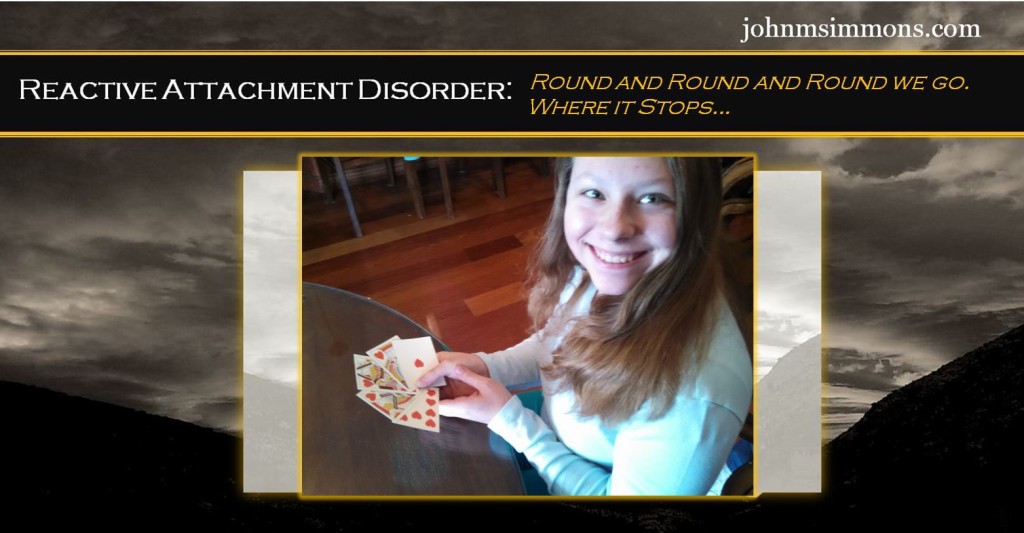RAD Cycles: Reactive Attachment Disorder
The RAD cycles experienced by people who suffer from Reactive Attachment Disorder and gambling addicts have quite a bit in common.
Round and Round and Round we go. Where it Stops…
I’ll (probably safely) assume that you have fewer vices than I do and that you are not overly familiar with the details of playing poker. Even so, I’m sure you understand the basis of drawing cards and trying to build a hand of favorable ones for betting purposes. Now, imagine there being no limits on the number of draws you could take. You can now take cards until you get whatever hand you want. Would you stop drawing before you had a Royal Flush (the perfect hand)? RAD cycles are based on such a principle.
In fact, the thought processes experienced by people who suffer from Reactive Attachment Disorder, and gambling addicts, have quite a bit in common. The development of Reactive Attachment Disorder is almost always incubated by an environment of inconsistency in caregivers and/or cause and effect. For most of us, we learned from our first moments that crying caused a reaction from someone else that solved whatever situation we viewed as painful, scary or detrimental. So, we cried until the problem was solved. Later we learned additional ways to consistently overcome negative situations and we implemented them because they worked fairly consistently. RAD cycles happen at least in part because those children who develop Reactive Attachment Disorder didn’t experience what we did when it came to consistent problem solutions.
Children being treated for Reactive Attachment Disorder go through RAD cycles much like gambling addicts keep returning to the card table.
When children who suffer from Reactive Attachment Disorder were experiencing their early lives, crying may have gotten them fed, or it might have rewarded them with a slap across the face. Their cries for help may have been heeded, or they might have been ignored. Every single action performed by these children was (if you will forgive me) a draw from a deck of cards. They never knew what they were going to get. So, if the first action didn’t get them what they needed (or wanted) they simply offered another action. If actions produce random reactions, you just need to keep drawing until you get the card you want. Unexpected (but desired) positive reactions release dopamine in the brain causing a “high.” That’s how people get addicted to gambling. Children being treated for Reactive Attachment Disorder go through RAD cycles much like gambling addicts keep returning to the card table.
The gambling addict isn’t stupid. He knows the odds he faces (perhaps better than those who don’t gamble). He knows that he probably won’t walk out of the casino as a winner at the end of the night. The addicted gambler probably isn’t playing for money, though, even if he says he is. His friends, counselors, articles he reads and even common sense tell him he will pay to play. But he gets a minor rush every time he draws a card he hoped for. The rush is bigger when he wins a hand (regardless of how many he has lost). The dopamine high is through the roof on the very rare occasion when he is more successful than the house over an entire night. Attempts to convince himself not to go back for that high ever again are David in the face of Goliath. That brings us back to RAD cycles.
That increased reward is well worth the gamble, so the child RAD cycles back to what they have experienced rather than what we try to tell them is best.
Just like our gambling friend, children with Reactive Attachment Disorder have a difficult time walking away from the chance at an unexpected shot of dopamine. Though we try to show as much consistency as possible to retrain the brains of our children with RAD, we can’t be perfect. In fact, since the good results from bad actions are so much more rare than they used to be, the brain-chemical reward that our children get when they beat the system is even better than it was. That increased reward is well worth the gamble, so the child RAD cycles back to what they have experienced rather than what we try to tell them (or even what they know) is best.
Even if our children who have Reactive Attachment Disorder become completely convinced that consistency is now the norm, it is difficult to stop RAD cycles. The gambler’s life is so much more exciting. Who would want the life of boredom provided by a nine-to-five job once they have experienced high rolling life on a river boat?
Often, readers receive as much help from other readers in the comments section as they do from the blog article, itself. Please be generous with your thoughts and experiences in the comments section. There are lots of people who need what you have to share. This is your chance to help them.
Read more blog articles by John M. Simmons about Disorders/Mental Illness
Return to John M. Simmons’ Blog
Ensure you don’t miss anything when you sign up for notifications

